When is the Best Time to Harvest Autoflowering Cannabis?

- 1. How to know if my autoflower is ready for harvest?
- 2. Harvesting based on the seasons
- 3. The vegetative stage: week 1-5
- 4. Ripening of the buds
- 5. Flushing
- 6. The harvest window
- 7. Approximate breeder’s schedule
- 8. When you notice less water usage
- 9. Yellowing and dying fan leaves
- 10. Calyxes become plump
- 11. Color of the stigmas
- 12. States of the trichomes
- 13. Early harvest vs late harvest
- 13. a. Early harvest
- 13. b. Late harvest
- 14. How to harvest, dry, trim, and cure your cannabis crop perfectly
- 15. In conclusion
The best time to harvest your plants depends on factors like proper flushing and the effect you wish to get, every plant is different and the only way to be sure is to take in consideration all the signs your plant gives, especially the stigmas and states of the trichomes. Once you develop the eyes to see, you’ll realize your cannabis plants send out a host of visual cues to signal the best time to start chopping stems and branches. These signs range from large structures such as leaves shifting color, to the changing aesthetics of tiny components of cannabis anatomy. However, you need to know what to look at and what to look for to make this judgement. Below, you’ll discover the key signs to seek to determine a timely harvest from your autoflowering cannabis plants.
After you properly flush your autos, there’s a “harvest window”, this is the time when your plants are ready and you have to decide when to harvest marijuana. There are several things to have in consideration and depending on when you do it, you can get a different type of effect so read along to learn more on how o get a good cannabis harvest.
1. How to know if my autoflower is ready for harvest?
It really doesn’t matter if you’re growing indoors or outdoors, the time will come and you’ll have to harvest cannabis plants. Now, cutting a plant isn’t hard at all but if you’re a first-time grower it can be hard to know exactly when to do it, depending on the plant (Indica or Sativa-dominant) and if it's an auto or photo, it can take a lot more (or less).
| Autoflowering | Photoperiodic | |
|---|---|---|
| Sativa | 10 weeks | up to 16 weeks |
| Indica | 8-9 weeks | 12 weeks |
The best time to harvest weed depends on a combination of different factors and what you desire to get, it can take a little bit longer if you want to properly flush your plants or get a more Indica-like effect or less if you prefer a more Sativa-like effect, either way, the best time to harvest marijuana (once your plant is in the “harvest window”) will depend on the type of effect of your preference.
2. Harvesting based on the seasons
Planning your harvest by the seasons depends on the place you live in and in knowing the expected weather. For example, during summer you can get up to 15hrs of sunlight, but when autumn comes the amount of sunlight decreases drastically, although this won’t make your autos flower because they don’t depend on a light cycle to start flowering, it can affect yields.
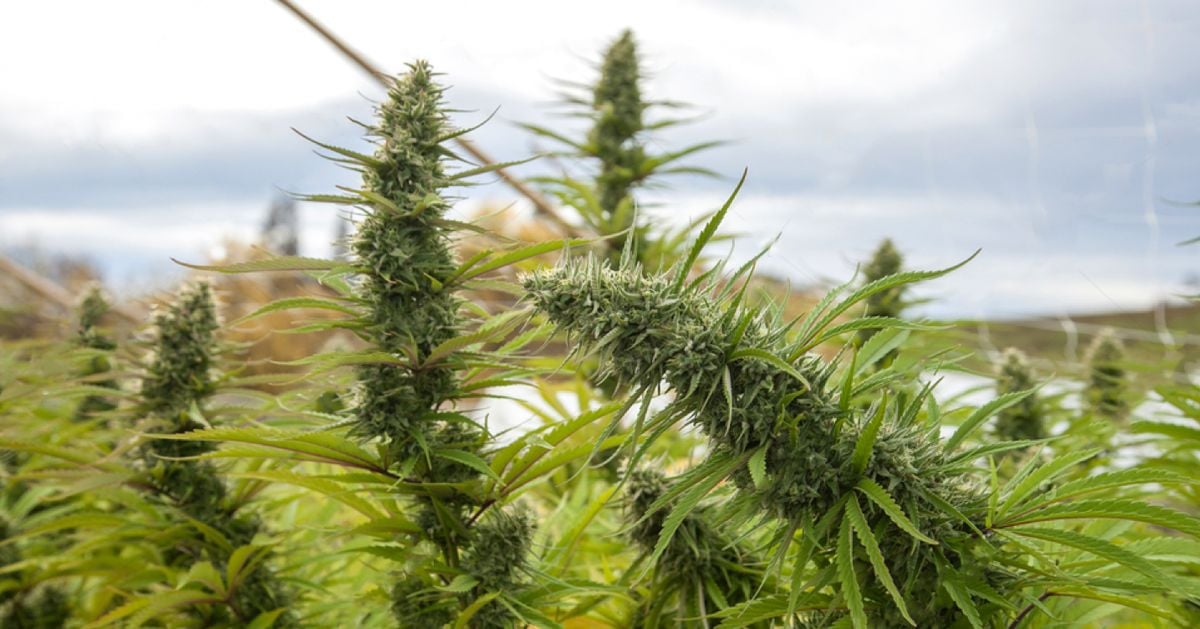
The best way to prevent this is to make a grow calendar before germinating your seeds, some places can get as little as 9:30hrs of sunlight during winter so by planning ahead you can get more yields and know when you’re going to harvest your plants. The best time of day to harvest you plants is early in the morning, before the sunrise and if you can, leave your plants in darkness for even more. Leaving your plants in complete darkness for up to 48hrs will let your plant know that she's about to die and she will make a final effort to produce more trichomes, resulting in a better harvest.
This also applies to cannabis plant grown indoors but because you are growing in an enclosed space there's no need to harvest before the sunrise, you can turn the lights in your growing tent off and leave them there for approximately 2 days.
3. The Vegetative stage: Week 1-5
Before starting to look for the signs that indicate your plant is completely mature, she has to go through the whole vegetative stage which starts as soon as your plant starts performing photosynthesis, starting from week 1 all the way to week 5 with autoflowering strains. In the vegetative stage (aka growing phase) your plants will only develop their structure and even though they're not producing buds, it's super important because it's the period your plant has to grow the leaves which are used in photosynthesis and develops the branches and stem, which are the part of the plant that support the buds.
Without a proper growing phase, the branches can snap if the buds fatten up too much, or if your plant doesn't grow too much, the yields will be affected. Achieving optimal plant health during the vegetative phase will pay big dividends when harvest time swings around. Cannabis plants spend this period packing on size and developing large fan leaves that act as biological solar panels to convert light into sugars. Interestingly, plants only use some of this energy themselves. They send the rest out into the rhizosphere—the small slither of soil around the roots.
Here, these sugary exudates attract all kinds of microbes, including symbiotic bacteria and fungi that help with nutrient uptake and pathogen resistance. Early research shows that a healthy microbial community in the soil might even contribute to increased cannabinoid production (think THC and CBD) in the flowering phase—highlighting the importance of organic growing methods. Overall, the vegetative phase serves to develop plant structure and future bud sites, as well as disease resistance and nutrient cycling in the soil; it lays the groundwork for the flowering phase to come. In this video you can see a timelapse of our Girl Scout Cookies Auto from seed to the last week of its cycle, notice how not only the leaves but also the branches slowly start to develop and get thicker and thicker each day, these are signs of a healthy plant. By maintaining a good growing environment you ensure your plant is happy and healthy and that is the best way to guarantee a good harvest.
4. Ripening of the buds
Before you are in the “harvest window”, your auto plant needs to develop and ripen the flowers. This starts when your plant enters the pre-flowering stage (around week 5) and can take up to 5 weeks (depending on the strain). It’s during this time that a basic knowledge of cannabis anatomy comes in really helpful. There are two key components of cannabis buds that you’re going to start tracking for the rest of the flowering phase: Trichomes and pistils. Let’s start with the trichomes. These tiny mushroom-shaped glands are responsible for the frosty layer that coats cannabis flowers; they also churn out the viscous resin that makes buds sticky.
Three major different forms of trichomes occupy cannabis flowers and, to a lesser extent, the leaves: Bulbous, capitate-sessile, and capitate-stalked. Of these three, the capitate-stalked trichomes produce the highest concentration of valuable secondary metabolites in the form of cannabinoids such as THC and CBD and terpenes including pinene, limonene, beta-caryophyllene, and myrcene. Further down the page, you’ll find out how their appearance indicates the ripeness of cannabis flowers.
Pistils comprise the second part of cannabis anatomy that you need to know about when it comes to determining cannabis flower maturity. Pistils are essentially the reproductive organ of female cannabis plants and feature several important components. At their base, they possess an ovule-shaped piece of plant tissue known as a bract, from which hair-like structures known as stigmas protrude. The stigmas play an important role in cannabis breeding, as they force flowers to start going to seed upon contact with male cannabis pollen. However, they also come in handy when looking to harvest buds. Just like the trichomes, they also change in appearance to indicate ripeness (more on that later on).
Week 6
Around week 5 your auto is entering the pre-flowering stage and you will see stigmas (white hairs) starting to come out from the pistils, the pistils contain the ovule, style and stigmas and are responsible for producing the seeds when they get pollinated.
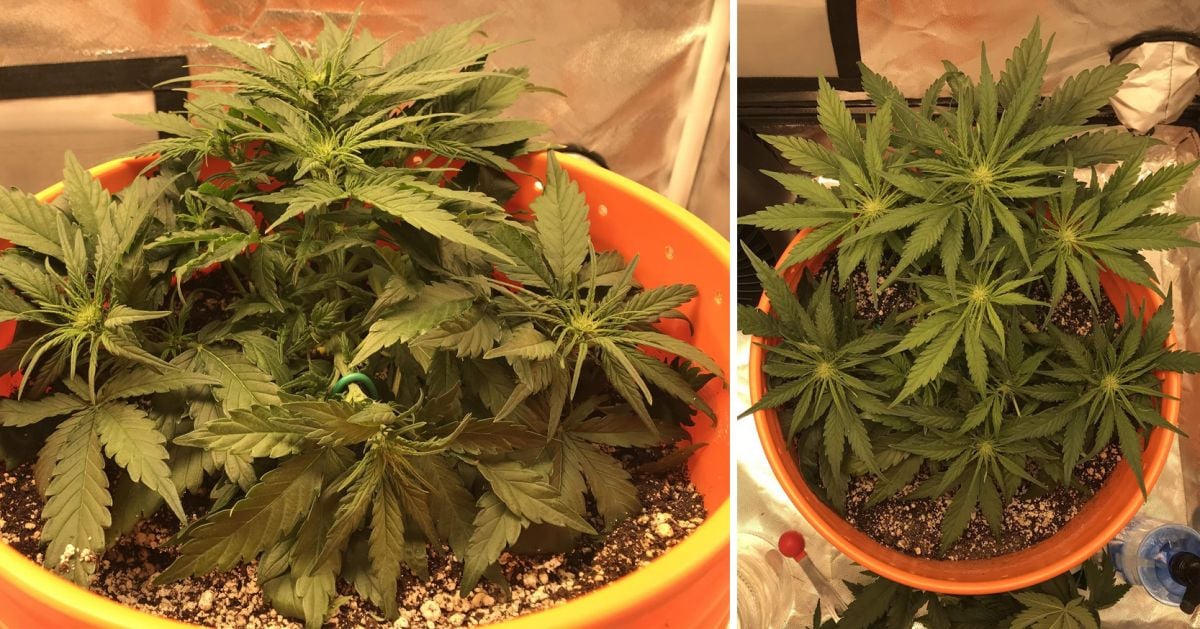
This is his first time growing autos, by keeping the temperature steady and the right humidity he was able to grow a really healthy plant, with beautiful dark green leaves and several bud sites.
"Starting to smell, really defoliated a lot last week and lots of lst. This week I’m going to let them recover. They are very thirsty girls, lots of nutrients and water and they keep asking for more."
Week 7
In the second week, your auto is in full flower and you will start to see a lot of stigmas and your buds getting thicker and thicker each day.
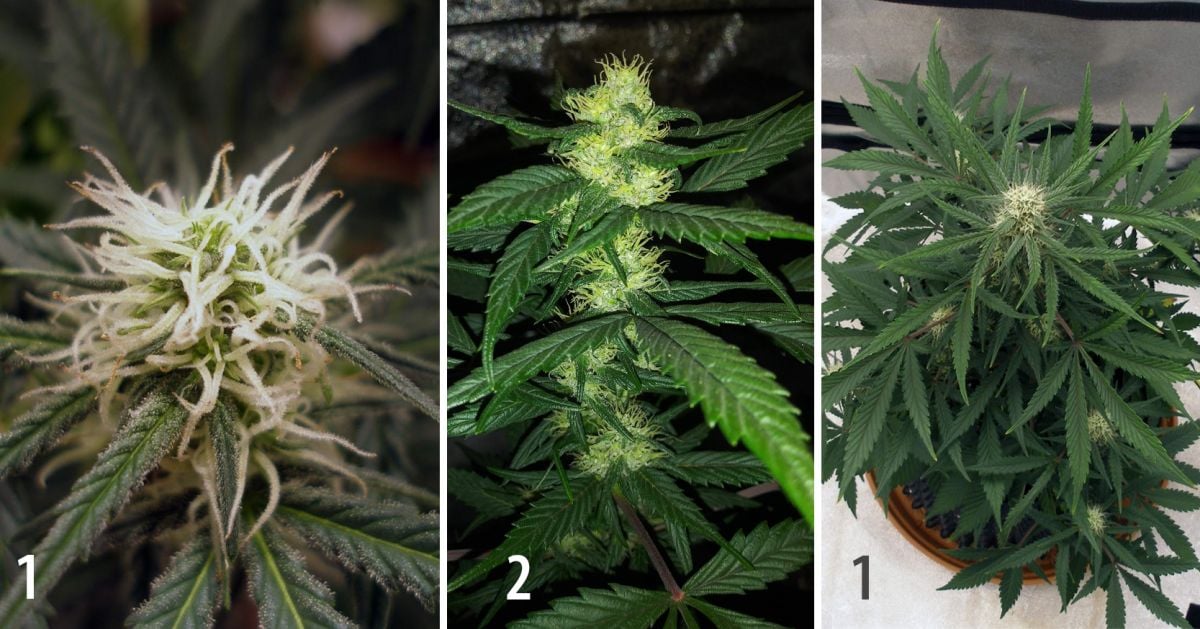
In this stage is when your plants usually start to smell really strong, if you live in a place where cannabis smell can be an issue, it's recommended to install a carbon filter to help eliminate the smell. As you can see, the bud sites are starting to develop a lot of pistils and the trichomes are starting to appear in abundance, this is usually when cannabis plants start to smell but that can vary depending on the strain you're growing.
During this time, you need to remain aware of both temperature and humidity. You can track both of these variables at the same time using a hygrometer. Outdoors, you’ll be at the mercy of the elements. However, you can influence humidity in greenhouses and polytunnels by opening windows to increase ventilation. Indoor growers have the advantage here. In this synthetic space, cultivators have almost complete control of temperature and humidity through the use of equipment such as fans, dehumidifiers, and air conditioners. Overall, you’ll need to aim for a consistent relative humidity of 40–50% (around 10% lower than in the vegetative phase). Why? Because, under the wrong conditions, cannabis flowers serve as an ideal environment for fungal pathogens to thrive. Reducing humidity and increasing airflow will prevent these diseases from getting a foothold and ruining your harvest.
Week 8
By the third week, the flowers start to ripen, you may be able to see the tip of some stigmas starting to turn brown, also, the amount of trichomes will be more visible although the trichome heads aren’t full of terpenes and cannabinoids yet. During this period, you’ll need to reduce the levels of relative humidity in your growing environment even further. As flowers become even more dense and full of moisture, they become increasingly attractive to opportunistic fungal pathogens. If you’re growing indoors or in a greenhouse outdoors, aim for a reading of 40–45% on your hygrometer.
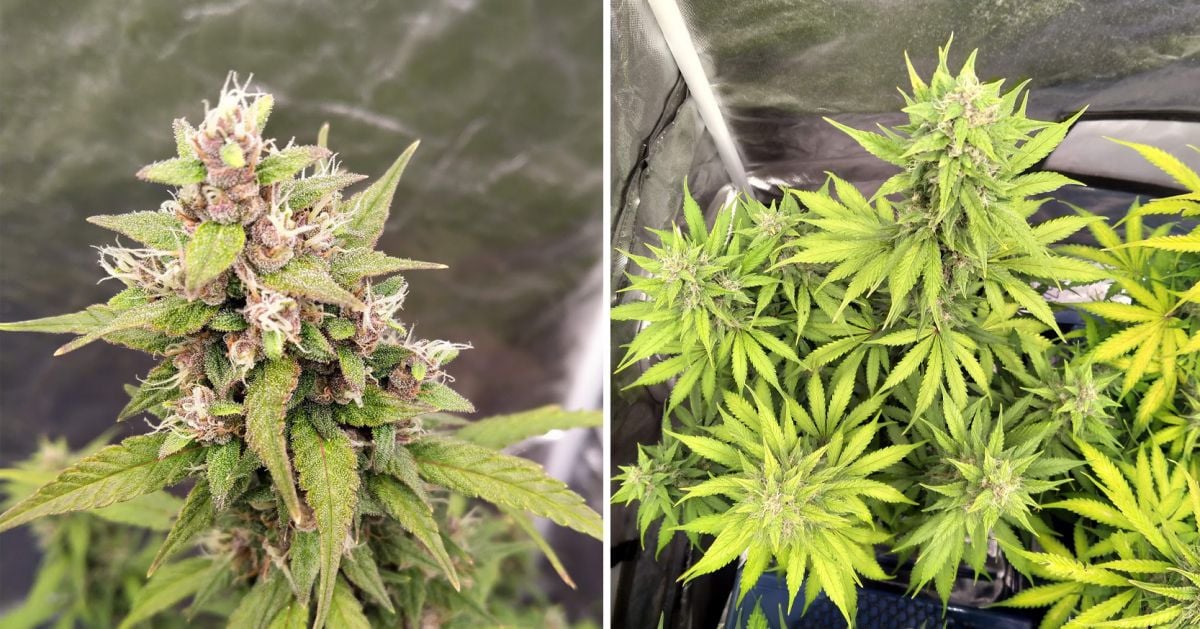
In this week your buds should be starting to fatten up, with some pistils already turning brown and, in some strains, different hues will start to appear. In this case, the LSD-25 started to fatten up the purple calyxes, swollen calyxes is a sign your plant is getting ready to be harvested and is something you should be on the lookout for.
Week 9
On week 4 almost all stigmas will have turned brown, the calyxes will be fat and plump, and there will be an abundance of trichomes that contain a good amount of terpenes and cannabinoids but are not yet full and have not reached its peak potency.

This is the week before the last one and you can see it in the photos our growers were happy with the density and aroma of the buds, which are completely covered in pistils and extremely frosty, at this stage you are only waiting for the flowers to get ready.
"It is however consistent in the aroma it puts off, very fruity and pleasant. Buds are thickening you and are beautiful, I just love this strain!"
Week 10
By the fifth week, your plant should be completely mature, with the trichomes completely upright and full of the compounds that you love.
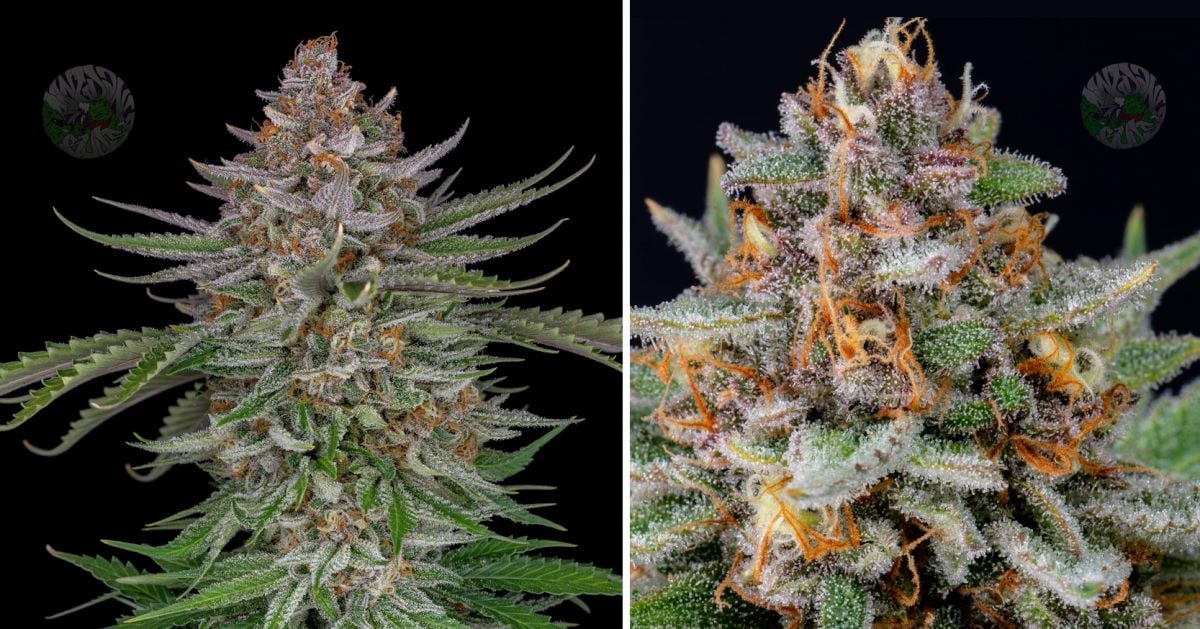
After your plant has completely finished it's life cycle, you are ready to harvest it, so if you were wondering when to harvest cannabis, this is the time. Although this doesn't mean you can smoke it right away. To be able to smoke your flowers properly and experience the flavors and effects you still need to dry and cure your buds.
You can clearly see there are still some white pistils but the majority is already brown and the plant is extremely frosty with the trichomes cloudy, this means it's ready to be harvested and will have a more cerebral effect.
5. Flushing
The first step to harvesting your autoflowers is 'flushing' the plant. Flushing consists of washing the excess nutrient off the medium and roots, and it’s the best way to ensure your buds aren’t harsh and have a delicious smell and taste, this process should be started 2-3 weeks before harvesting, especially when using synthetic nutrients. This gives the plant time to use all the remaining sugars and nutrients its storing. If you don't flush, excess amounts of both end up in your final product, and they burn alongside your bud, giving it a harsh feel and flavor.
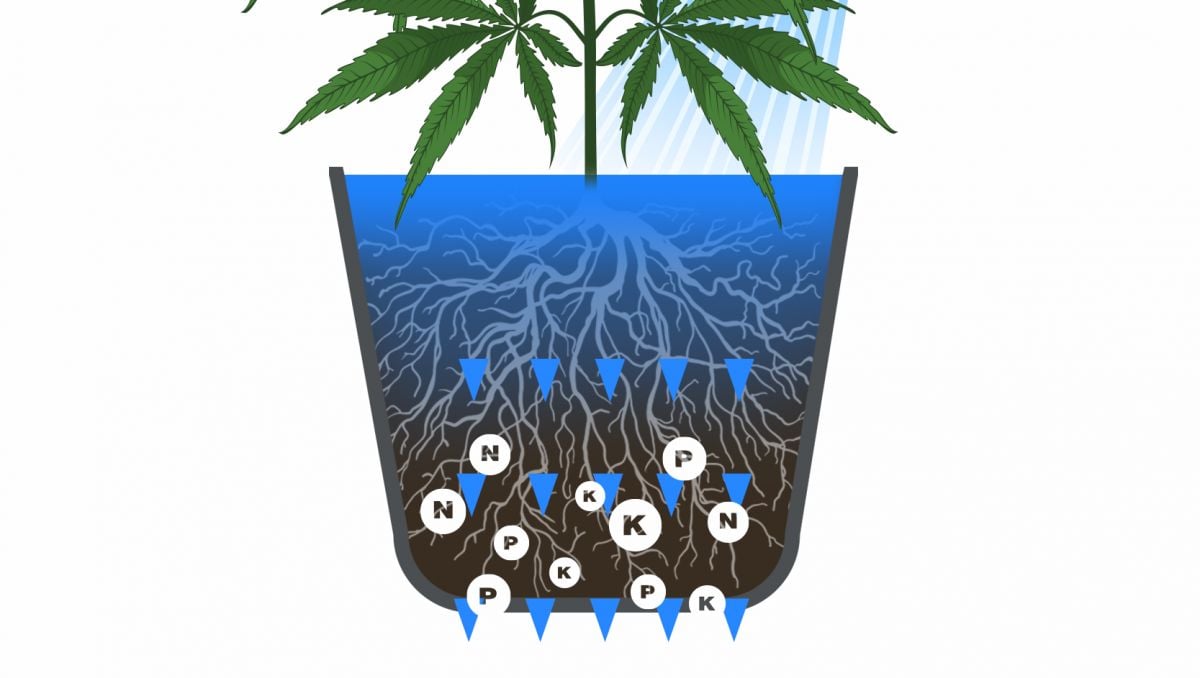
How long you flush depends on your growing medium, but the result is the same. Flushed weed is incomparably smoother. When to start your flush is up to you, but one sure sign an autoflowering plant is ready to go on a terminal diet is yellowing leaves. If your fan leaves have been lush and green throughout, the first signs of yellowing let you know it's time to begin the harvest process and start flushing.
6. The harvest window
The harvest window refers to the last days of your auto’s life cycle. It starts once you’ve started flushing: the leaves are turning yellow, your plant is not absorbing any more nutrients, and is almost ready for harvest.
Tip: When you’re in the harvest window, you have to look at different parts of the buds. You can get a more cerebral effect, a corporal effect, or a mix of them both if you know exactly when to harvest to get the desired effect.
You need to take a look at a combination of the following elements to be able to harvest at just the right time.
7. Approximate breeder’s schedule
Almost all breeders give you an approximate number of weeks a certain strain takes from seed to harvest, this schedule depends on your growing setup and should not always be followed.
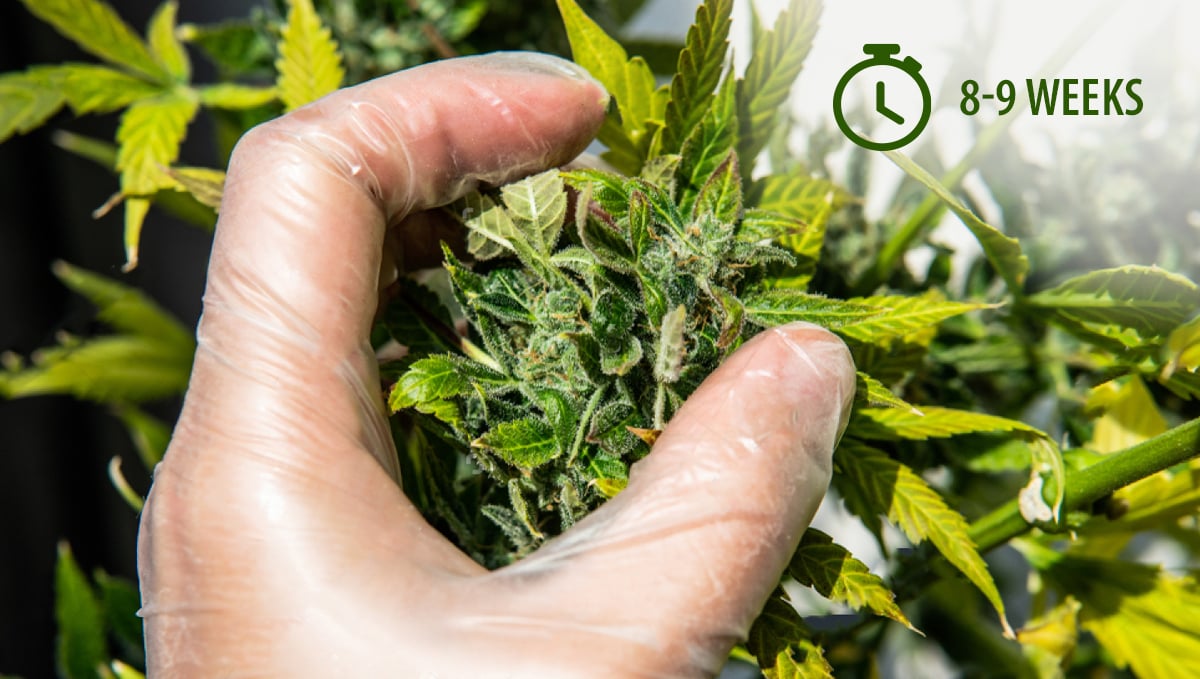
Obviously, that information can be used as a guideline but remember that breeders have top-notch growing spaces so how long your plants take will depend on your growing conditions. Cannabis plants can take less or more time than what is specified depending on the intensity of the light, you should not harvest exactly when they say but you can use it to start looking for the signs that your plants are almost ready for harvest.
8. When you notice less water usage
When a cannabis plant is almost ready for harvest it won’t absorb too much water because it’s in the process of ripening the buds and doesn’t need to grow more.
- Throughout your plant's life cycle, you’ll be able to see how long it takes for the soil to dry;
- If your plant is maturing and it’s not absorbing too much water, it’s a sign that it's almost time to harvest;
- Although this isn’t too precise, it should be taken into consideration but not used as the only parameter to harvest the buds.
9. Yellowing and dying fan leaves
If you flush properly you will start to see the leaves yellowing and dying at the end of your autos life cycle, this means your plant is not absorbing any more nutrients and is focusing the energy on the buds.

Yellowing leaves are a sign of deficiencies and are a problem at any other stage but in the final weeks it’s completely normal, this means you’re successfully removing the excess nutrients and your plants are getting ready to be chopped off. While they’re not receiving ionic nutrients in the form of a bottled NPK fertiliser, your plant will likely still be obtaining low levels of nitrogen through the beneficial bacteria living in the soil. However, this big reduction in nutrients will cause plants to start working through their internal stores. Because cannabis relies so heavily on nitrogen as the basis of amino acids and proteins, plants start to turn yellow and drop leaves when it’s absent. During flushing, this results in lower levels of nitrogen and other nutrients in plant tissues which creates a smoother and less harsh smoke after drying and curing buds.
10. Calyxes become plump
Calyxes are the part of a cannabis plant that protects the reproductive organs and what form the buds, they are designed to hold the seeds when a plant is pollinated and are the first sign of flower formations, they start as a bunch of small leaves and fatten until the flowers are fully formed. When you are near harvest time, you'll see the calyxes are round and plump, this is another sign that your plant is reaching maturity.
11. Color of the stigmas
Pistils grow from the stigmas1(like mentioned above) and they can be a sign that your plant is completely mature. These long, hair-like organs on the surface of the bud usually start out whitish-green and darken to brown, and red as time goes on. Although it isn’t a rule because some autos can have brown pistils and still need a couple of weeks to be harvested.
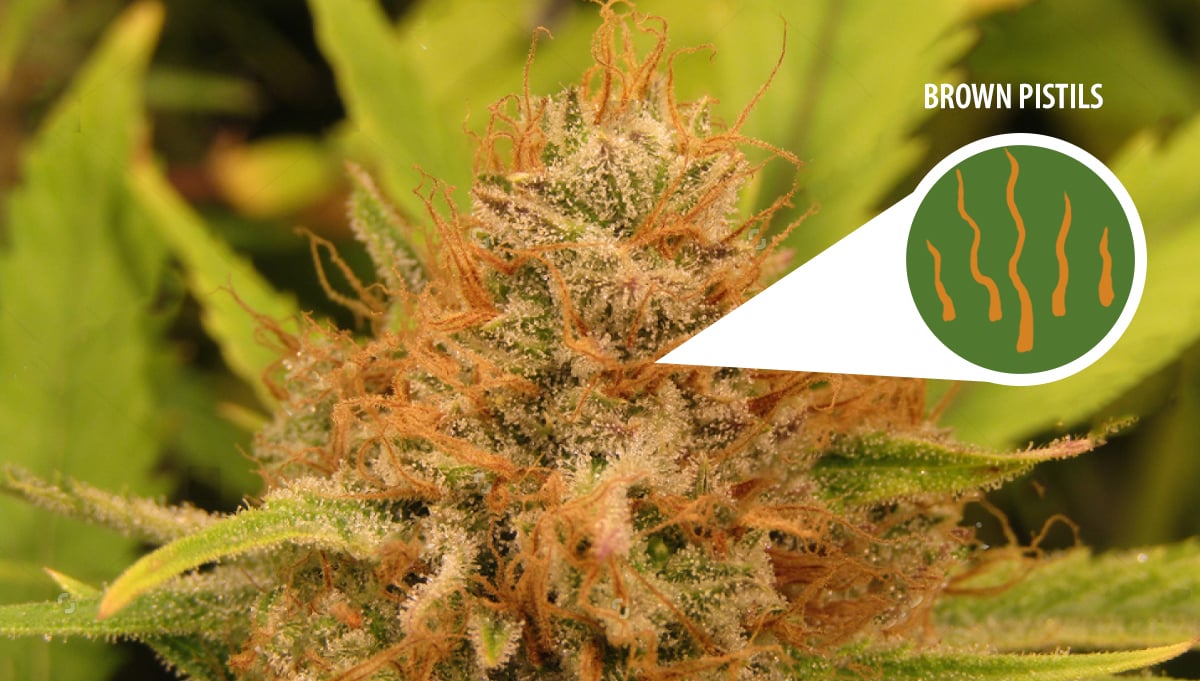
The stigmas are the part of the cannabis plant that catches the pollen to produce seeds, when they aren’t pollinated they will start to turn brown and wilt, when around 60-70% of the pistils are brown it means a plant is reaching the end of its life cycle and can be ready or almost ready for harvest.
This method is easy to do and requires no specialized equipment, but it's not the most accurate or reliable. New pistils can appear overnight, setting your time to harvest back days. Some strains are more prone to producing dark-colored pistils, regardless of how ready to harvest they are.
12. States of the trichomes
The sticky trichomes basically consist of a stalk and a head or cap, they contain terpenes and cannabinoids that are produced in the trichome’s head and are responsible for a plant’s aroma.
The smell of a cannabis plant gets more intense throughout the flowering stage because there are more trichomes on your plant and when you reach the harvest window the trichomes also go through a ripening process.
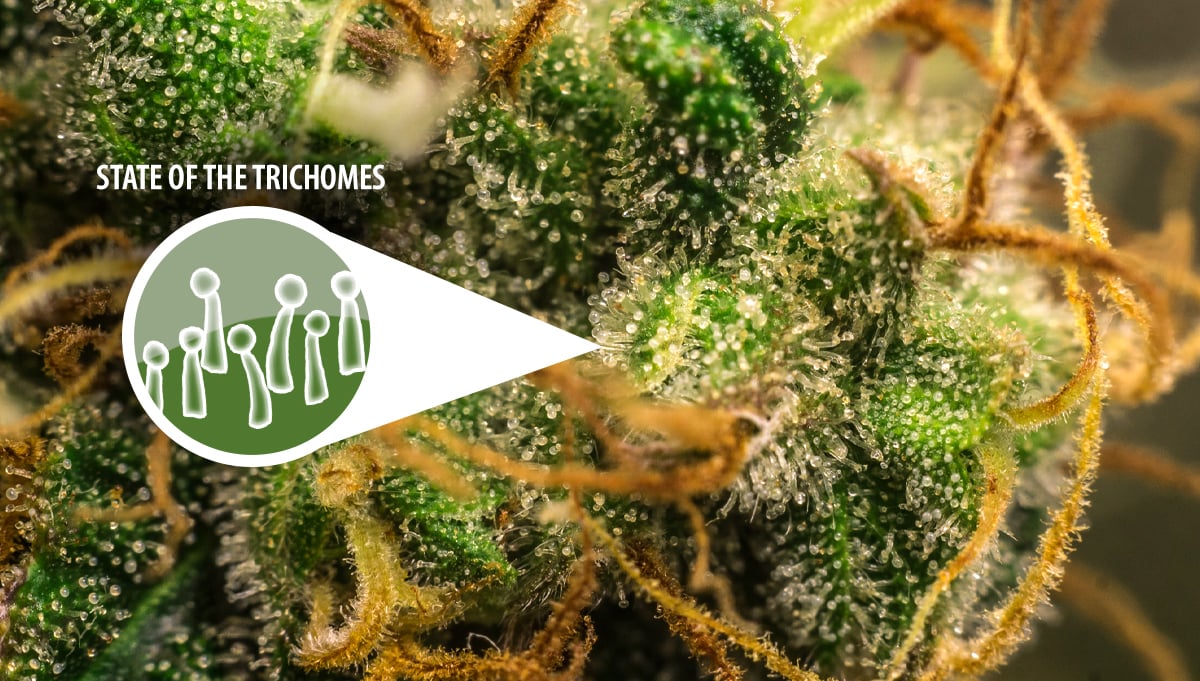
In order to be more accurate than looking at the stigmas, you're going to have to look at the trichomes, the sticky balls of resin you see on well-grown bud. These specks contain most of the THC and other cannabinoids you love to smoke.
Trichome color is considered the standard indicator when finding the right time to harvest, when your plant is ready for harvest the trichomes will start to ripen, the cannabinoids will start to deteriorate, and depending on when you harvest them, you’ll get a different effect.
Even though you can view the trichomes without equipment, a simple magnifying glass should be enough to get a good view of their plant's trichomes. More serious growers, however, will probably want to go the extra step of investing in a high-quality jewelers loupe to get a better view.
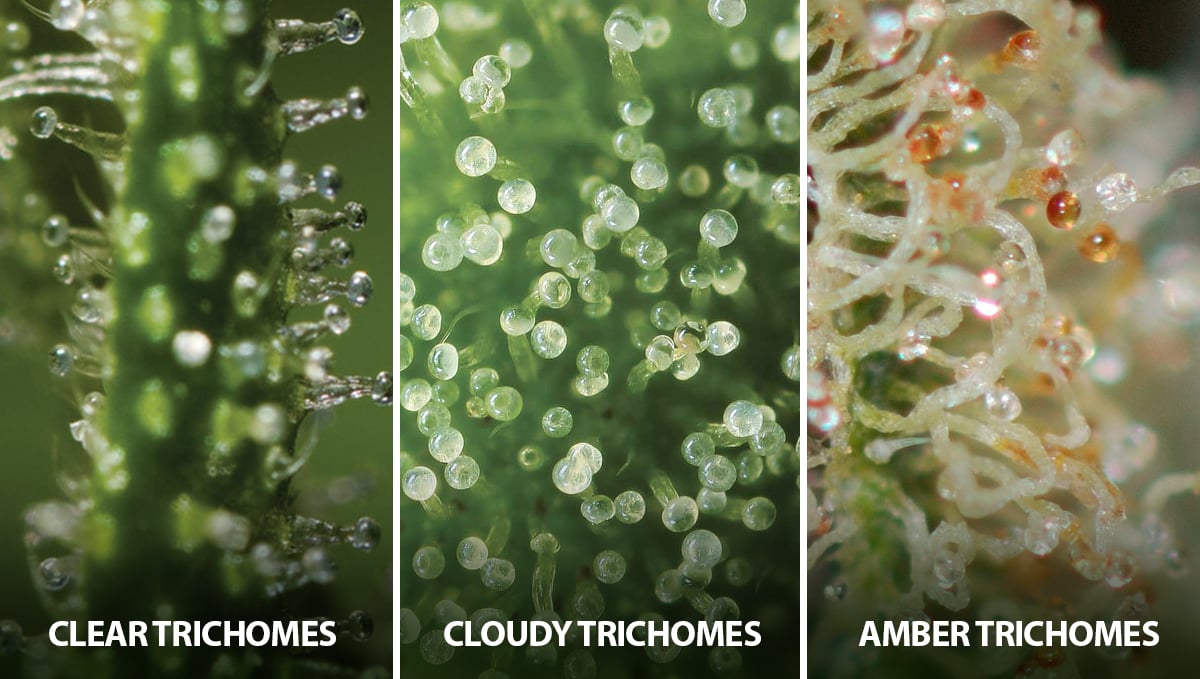
Professional growers take that even further and often use digital microscopes to get the best view of their buds. Depending on the laws where you live, you may find these microscopes at your local dispensary or cannabis club. Customers can use these to confirm their weed is properly grown and harvested before purchasing.
Under magnification, trichomes take on the appearance of mushrooms made from crystal clear blown glass. As the plant nears harvest time, their transparent appearance will grow cloudy and if left for longer they will turn amber. If this is your first grow, it will take your time to learn to tell them apart.
13. Early harvest vs late harvest
What happens if you’re forced to move your harvest date?
If for any personal problems you're forced to harvest your plants early (or late), the trichomes will not be mature enough or they will keep degrading over time so you should take a look at your plant and decide what is best for your case.
Early harvest
If something happens and you're forced to have an early harvest or late harvest, you'll probably not be harvesting your plants when they are more potent, if you harvest early the trichomes will not be fully mature and the effect when consuming your buds won't be as strong.
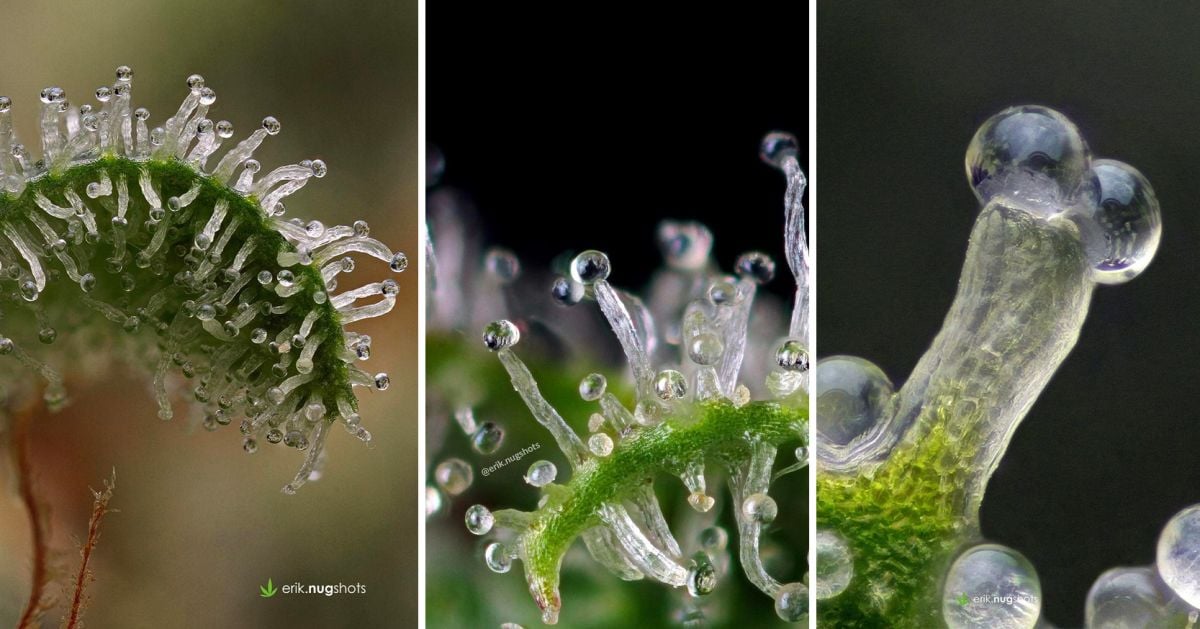
Immature or clear
Immature or clear trichomes are not potent because the cannabinoids are not fully developed, this means you will not have a psychoactive effect so you shouldn’t harvest yet but be on the lookout because it won’t be long until the trichomes start turning cloudy. In the final weeks of flowering and even on harvested weed, the trichomes can mature in a couple of days or even overnight so keep an eye on them so you harvest at the right time.
Mature or cloudy
When the trichomes are mature2 or cloudy is when they are their peak potency and it’s when you should harvest your plants if you want a cerebral kind of high, have in mind that it’s impossible to harvest when all the trichomes are mature because your plant will continue to produce new trichomes until it’s chopped.

So to get this effect, you can harvest your plants when around 85% cloudy, the other 15% being a mix of amber and clear trichomes.
Late harvest
If you harvest late, the trichomes will start to age and as they turn amber the THC will start to turn into CBN, resulting in a more Indica-like, corporal effect. Even if they've gone from cloudy to amber, you're still OK, but because the THC has turned into other cannabinoids, the effects you get when smoking will change a bit. This isn't usually a problem if you're aiming for a strong Indica high, but it's crucial you harvest at the right time if you were hoping for a Sativa-like type of effect.
Overripe or amber
Overripe trichomes are those which have turned amber because the THC has begun to degrade into CBN, although this isn’t desired by many, some consumers prefer a more corporal and narcotic effect so if you desire that type of effect, this is when you should harvest your plants.

Remember that you can harvest your plants when you want to, by knowing the effect of clear, cloudy, and amber trichomes you can effectively harvest your plants to get the effect you want, you don’t necessarily have to harvest when the trichomes are 85% cloudy or amber. For example, you can harvest weed when the trichomes are 50% amber and 50% cloudy so you get a balanced effect or at any ratio, you wish to, as long as you don’t harvest too early.
14. How to Harvest, Dry, Trim, and Cure Your Cannabis Crop Perfectly
You've done it. You have successfully made it through the full life cycle. All that hard work, dedication, sleepless nights, and countless hours of tending to your crop have finally paid off. Now it's time for the most important part; harvesting, drying, and curing your cannabis crop perfectly. You might think that the tough stuff is finished, but the war wages on my friends. Growing the crop successfully is really only half the battle. Harvesting at the right time, drying your crop correctly, and then curing it to ensure you are left with the very best possible bud is a battle in itself, and one that is often overlooked by novice growers.
Many a cannabis crop has been wrecked by incorrect drying methods, and if you want your nugs to reach their full potential in terms of terpene and cannabinoid maturity then you're going to have to let them sit and cure once nicely dried. But, how do you go about cutting the crop down? How long does it need to hang and dry? Should it be left to hang as an entire plant, or bucked down to the individual branches? How long does the curing period need to last? Let us find out....
Harvesting Your Crop
Ok, we have already run over how to tell when your cannabis plants are ready for harvest, but what is the best way to cut the crop down? Well, that depends on a bunch of factors. For example, if you are growing indoors then it may be best to cut the entire plant rather than individual branches as this is less time-consuming. Indoor cannabis plants rarely grow taller than 1.5 meters and are usually controlled to be a smaller height than this. If you have space to hang the entire plant as one, then go for it.

However, if you are growing outdoors and have limited space in your drying room then bucking down the individual branches may be the way to go. Outdoor plants can get huge, so it may simply not be practical to hang an entire plant in your drying room. There are other factors at play though. If you live in a particularly humid climate and are struggling to control the moisture levels in your dry room, you may want to break the crop down to the branch level no matter the size of the plants. This will speed up the drying process and reduce the chances of mold issues arising. The opposite is also true - if you live in a particularly dry area, you will want to leave the plants as whole as possible to make sure they do not dry too quickly.
Trimming and Drying Your Crop
Drying cannabis is a delicate process and can make or break the end product. Too quick and you will be left with some harsh, unpleasant-tasting bud. Too slow and you may end up with some nasty mold on that flower you worked so hard to produce - the worst possible outcome. Let's talk first about trimming, as the decisions you make here have a heavy effect on the drying process. There are two options - wet or dry trimming. Just like with harvest decisions, the climate will be the deciding factor here.
Wet trimming is when you remove as much of the plant material as possible before you hang the buds up to dry. This will speed up the drying process immensely, and should only be done in high-humidity conditions. In general, you want to keep the drying process nice and slow, as this ensures a minimal amount of cannabinoid and terpene degradation. Dry trimming is when you let the plant dry as a whole, or as bucked-down branches, and then trim. This is the preferred method for most large-scale operators, as dry trimming is much easier than wet.
When trimming, you want to use a specialized set of scissors or trimmers and not just any old pair of scissors that you found in the third drawer in the kitchen. We all have that pair, and they all suck. Trimming weed is a slow, tedious process and can quickly turn into a true labor of love - especially with the wrong tools. There are a bunch of options out there, so make sure to do your research and get the best trimmers that you can afford. Be careful not to 'shave' the buds. You want to use the tips of the scissors to dig deep into the buds and cut the leaves as close to the base as possible while trying to keep the actual flower formation as intact as possible.
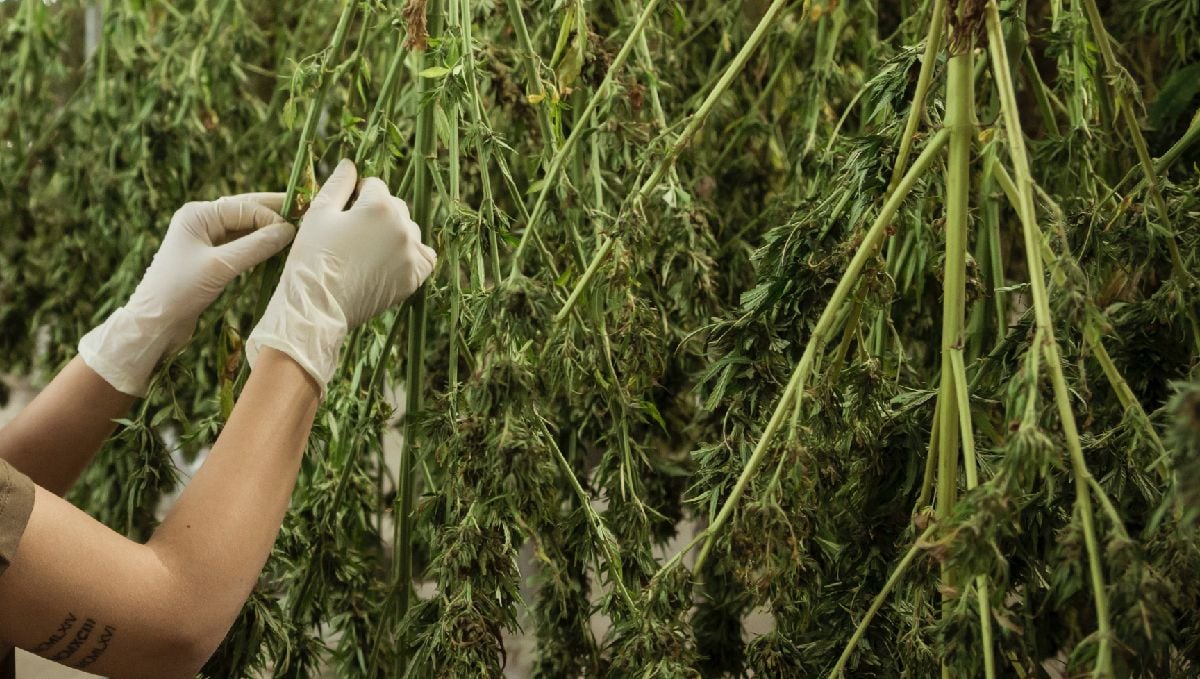
You also do yourself a huge favor if you grab a proper trim tray. These are awesome, and will actually make you money in the long run. How? They catch all the trichomes that fall while trimming and allow you to make whatever you like out of them. You might think this a little bit of overkill, but you will be shocked at how much they actually do catch. Why waste all that gorgeous kief you've worked your ass off for?
The ideal dry room should be kept at around 50% relative humidity, and at around 22 degrees Celcius if possible. You want the room to be well-ventilated as this will aid in the drying process and help reduce the chances of mold. Don't have any fans or AC units pointing directly at the buds though. It should also be nice and dark, as UV is a cannabinoid killer once the plant has been cut down. You can use your grow tent as the dry room if you like, but you can also build a DIY one super easily out of a large cardboard box. To make your own DIY dry box, grab:
- A large cardboard box
- A roll of twine
- Scissors
- Tape
- A cheap computer fan, and battery (optional)
Then:
- Start by making holes in the cardboard box for the twine. You want them to be at regular intervals, about 7 cm apart so there is enough room to hang the buds without them touching.
- Once the holes have been made, run the twine through to make hanging lines for the buds. You can make multiple levels.
- Remember to cut ventilation holes. You want the intake to be near the bottom of the box, and the exhaust near the top. You can add a computer fan to the exhaust to ensure proper airflow throughout the dry box.
- Depending on the size of the box, you may want to cut a door into the middle to help with hanging and then accessing the buds.
- Remember to tape up any holes that may allow light leaks, and keep in mind that drying buds stank, and stank real good. Might be best to keep this away from any nosey neighbors.
Curing Your Crop
So, you've managed to harvest and dry your crop correctly...congrats! Now it is time for the most important part of the process - curing. Hold up, my harvest is still not ready to smoke? Are you kidding??? Unfortunately not! Look, of course at this point you can start to smoke those delicious nugs but to get the very best you will need to let them sit and cure. Curing is essentially the process of aging your buds. It helps smooth out the flavors and makes them much more enjoyable to smoke. Curing is actually a very simple process - all you have to do is place your buds in an airtight container and let them sit for a few weeks. Make sure to 'burp' the container every day or two - this is when you open the lid just enough to let any excess humidity escape. This can be done for up to two months, or even longer depending on the strain.
Curing your buds correctly requires patience and dedication - but it is well worth it in the end. Keep in mind that there will still be very slight moisture levels in the buds while they cure, and this can lead to mold in some cases. If you smell even the slightest traces of ammonia, get them out of the containers quick smart and back into the dry room for a day or two. We like to use glass mason jars for curing, but you can use anything airtight container. Don't fill them past the 75% mark. This ensures there is enough air to allow the curing process to take place. Oh, and keep the jars in a cool, dark place for the entire curing process.
Expert Opinion by Jorge Cervantes - co-author
Determining the perfect harvest time for autoflowering cannabis is a skill that combines observation, experience, and a deep understanding of plant biology. As a veteran in the cannabis cultivation field, I've always emphasized the importance of harvesting at the right moment to ensure the highest quality and potency of your yield.
This article, co-authored with Enzo Schillaci, provides a detailed look into the signs that indicate when an autoflowering cannabis plant is ready for harvest. The key lies in observing the subtle changes in the plant, from the color and state of the trichomes to the pistils' behavior and the leaves' overall health. Each indicator tells a story about the plant's maturity and readiness for harvest.
One of the most reliable methods to determine harvest time is examining the trichomes. These tiny, resinous glands hold the essence of the plant's potency and flavor. Understanding their color changes and what each stage represents is crucial for harvesting at the peak of THC production or achieving the desired effect, whether it be more uplifting or sedative.
In conclusion, the art of harvesting autoflowering cannabis at the right time is a blend of science, patience, and keen observation. This article provides a comprehensive guide to mastering this skill, ensuring that your efforts in cultivation culminate in the highest quality harvest. Remember, each plant is unique, and getting to know your plants intimately is the key to successful cultivation.
15. In conclusion
Knowing when to harvest marijuana isn't an exact science, but these rules should steer you in the right direction. For the best results, you should combine the methods described above when deciding when to harvest weed. If you're shooting for THC-rich buds, you should harvest when 50%-70% of your pistils have changed color, and most of the trichomes have turned cloudy, this is the standard indicator for the best time to harvest cannabis.
We hope that after reading this article you get a good idea of when to harvest marijuana, remember that growing autoflower marijuana requires a lot of time and hard work but the results make it worth it, even after your plant is completely mature there’s still some work left to be able to enjoy your flowers.
Remember that harvesting cannabis doesn't end when you cut off the branches; The weed harvest process also includes, drying, and curing, and these processes are super important when growing cannabis, and not doing it properly can ruin the potency, taste, and smell of your buds, we hope our guide helps you and if you have any questions or encounter any problems, feel free to leave us a comment below!
References:
1, 2 Photos courtesy of Erik Christiansen - https://www.instagram.com/erik.nugshots/







Comments